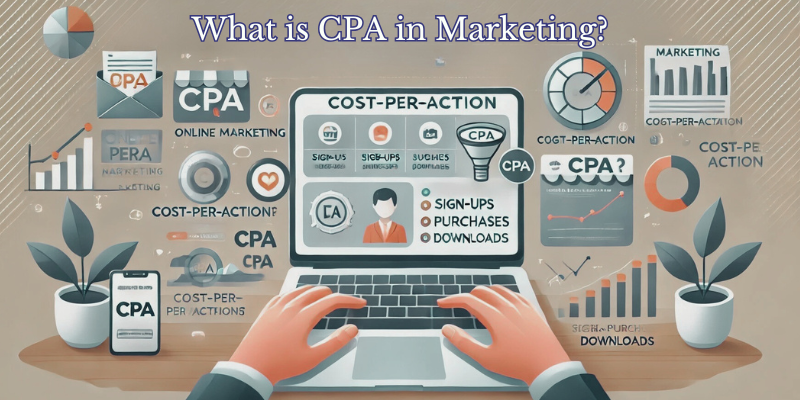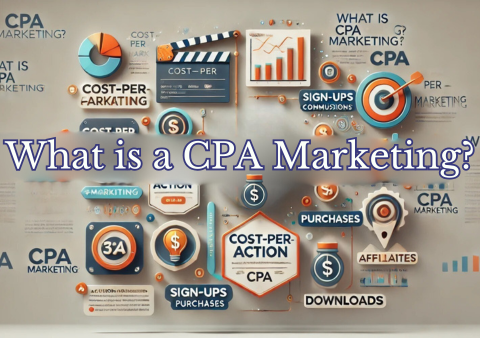CPA or Cost-per-action marketing, is a performance-based strategy where businesses pay only when a specific action is completed, like a sale, sign-up, or form submission. Simply put, the CPA marketing definition refers to any model where advertisers pay for results, not just clicks or views.
CPA affiliate marketing is a part of this model, where affiliates promote products or services and earn commissions for driving those actions.
Want to earn money online without complicated strategies or big investments? This article will explain how CPA marketing works, why it’s popular, and how to start.
Key Takeaways
- CPA marketing rewards affiliates for actions like sign-ups or purchases, not just clicks.
- Advertisers pay only for results, making it cost-effective and low-risk.
- Common actions include video views, form fills, and purchases.
- CPA networks connect affiliates with advertisers and track conversions.
- To start CPA marketing, choose a niche, join a network, and promote relevant offers.
What is CPA in Marketing?
CPA in marketing stands for Cost Per Action, a strategy where businesses pay affiliates only when a specific action—like a purchase, sign-up, or form submission—is completed.
Affiliates earn a commission when a consumer takes these actions. The key difference from other advertising models is that advertisers only pay when the desired action happens, making this a low-risk, cost-effective strategy.

Businesses use this approach to boost conversions while reducing advertising costs. Affiliates can earn by driving traffic to advertisers’ websites and encouraging specific actions.
Common Actions in CPA Marketing Campaigns:
- Watching videos
- Filling out forms
- Signing up for a trial
- Getting a quote
- Making a purchase
Types of Actions in CPA Marketing
Here’s a breakdown of common actions affiliates encourage users to take through CPA marketing:
- Video Views: Affiliates can promote video content, and they get paid when viewers watch the full video. For example, advertisers often use video promotions for product launches or tutorials.
- Filling Out Forms: Many advertisers pay affiliates when a user fills out a form. This could be a lead generation form, survey response, or even an inquiry form for more information about a service.
- Registration for a Trial: Some businesses offer free trials for their products or services. Affiliates earn a commission when users register for these trials, even if they don’t end up purchasing afterward.
- Getting a Quote: Affiliates often encourage visitors to get quotes for products like insurance or home services. When a visitor clicks through and completes the quote request, the affiliate earns money.
- Purchases: The simplest form of CPA marketing is earning a commission from user purchases. This occurs when someone buys a product after clicking an affiliate link. E-commerce promotions rely on this method the most.
The CPA Marketing Model
The CPA marketing model is based on three main parties working together:
- Affiliates (Publishers). These are content creators or influencers who promote products in exchange for commissions. Affiliates use various platforms to promote products or services. These platforms include blogs, websites, and social media channels.
- Advertisers (Businesses). These are the companies that create the products or services. Advertisers aim to grow their customer base and sales. They partner with affiliates who drive traffic to their sites and encourage users to take specific actions.
- CPA Networks. These are the platforms that facilitate the relationship between affiliates and advertisers. CPA networks connect businesses with affiliates and track conversions accurately.
Each player plays a vital role in the CPA marketing system. Affiliates drive targeted traffic through their platforms, while advertisers provide products or services. CPA networks track conversions to ensure affiliates are properly compensated.
Categories of CPA Marketing
CPA marketing has three main categories. Each offers different incentives for affiliates.
Pay Per Sale (PPS)
In this model, affiliates earn a commission when a customer makes a purchase. For example, an affiliate promoting an online store earns a percentage of the sale price. This happens whenever a customer makes a purchase through their referral.
Pay Per Action (PPA)
Affiliates are paid when a user takes a specific action, such as signing up for a newsletter, downloading an app, or filling out a lead generation form. This model is useful for advertisers looking to collect customer information or build a lead database.

Recurring Payments
Some programs offer recurring payments to affiliates. Affiliates earn these payments when customers make repeat purchases or subscribe. This model works well for businesses with subscription-based offerings. Examples include software and membership services.
Each category offers affiliates different ways to earn money. This depends on the types of actions they can get their audience to take.
What Are CPA Networks?
CPA networks are websites that connect businesses with people (affiliates) who want to promote their products. Businesses post offers, and affiliates choose which ones to promote to earn money.
The network tracks actions like sign-ups, purchases, or downloads and makes sure affiliates get paid when these actions are completed. Some popular CPA networks are MaxBounty, PeerFly, and ClickDealer. In simple terms, CPA networks help businesses find promoters and help affiliates find offers to make money from.
What Are Cost Per Action (CPA) Affiliate Programs?
Cost Per Action (CPA) affiliate programs are ways to make money online by getting people to do simple tasks, like signing up for a free trial, filling out a form, buying something, or downloading an app.
For example, if you share a link to a fitness app and someone downloads it, you earn a commission. You can promote these offers on websites, social media, or through ads, and you only get paid when the person completes the action, making it an easy way to earn money.
CPA is just one of the different types of affiliate marketing, with others including pay-per-sale, pay-per-click, and recurring commissions, each offering unique ways to earn based on results.
CPA Marketing vs CPA Affiliate Marketing
While CPA marketing and CPA affiliate marketing are closely related, they have some key differences and similarities:
| Aspect | CPA Marketing | CPA Affiliate Marketing |
| Scope | Broad model where businesses pay for actions. | A part of CPA marketing focused on affiliates. |
| Participants | Advertisers can run campaigns directly. | Involves third-party affiliates promoting offers. |
| Approach | Includes in-house ads, influencer deals, etc. | Relies on affiliates using blogs, social media, etc. |
| Performance-Based | Yes, payment is for specific actions only. | Yes, affiliates get paid when actions are completed. |
| Tracking | Uses CPA networks to track conversions. | Also depends on CPA networks for tracking actions. |
| Goal | Drive specific actions like leads or sales. | Same goal—drive actions to earn commissions. |
Why CPA Affiliate Marketing is Valuable
The value of CPA affiliate marketing comes from its low-risk, high-reward setup. Advertisers only pay for actual results, like sign-ups, purchases, or downloads. This makes it cost-effective because they’re not wasting money on ads that don’t deliver.
For affiliates, CPA affiliate marketing is a great way to monetize traffic without spending money upfront. You don’t need to create a product or service—you just promote offers and earn commissions when people take action.
Another big plus is that CPA affiliate marketing is scalable. The more traffic you drive and the more actions you generate, the more you can earn. It’s a smart strategy for long-term growth because both affiliates and advertisers benefit. Advertisers reach niche audiences, and affiliates keep growing their income without big investments.
How to Start Cost Per Action (CPA) Affiliate Marketing
Starting with cost per action (CPA), affiliate marketing is pretty easy if you follow these simple steps:
Learn the Basics
First, understand what cost per action affiliate marketing is. You make money when someone does something specific, like signing up for a free trial, buying something, or downloading an app through your link.
Pick a Niche
Choose a topic you like, such as fitness, gaming, or tech. It’s easier to promote offers when you’re interested in the topic.
Join a CPA Network
Sign up for a CPA network like MaxBounty, PeerFly, or ClickDealer. These networks have offers you can promote. Some might ask how you plan to promote them, so have a simple idea ready.
Choose Offers
Pick offers that match your niche and look interesting to your audience. Go for ones that pay well.
Promote Your Offers
Share your links on social media, websites, emails, or even with paid ads. The goal is to get people to click and take action.
See What’s Working
Use tracking tools (most networks have them) to see which offers are making money. If something isn’t working, try a different approach.
Make More Money
Once you know what works, put more effort or money into those offers to earn more.
Conclusion About What is CPA Marketing
CPA affiliate marketing is a simple and effective way to earn money online by promoting offers and getting paid for specific actions like sign-ups, purchases, or app downloads. It’s a low-risk strategy because you only get paid when results are achieved.
To succeed, focus on practical steps: choose the right niche, join reliable CPA networks, and track your results to see what works best. This approach helps you grow your income steadily while learning what marketing strategies bring the best results.
FAQs About CPA Marketing
What is CPA marketing?
Cost Per Action marketing, is a way for businesses to pay for specific results, like a sign-up, purchase, or form submission. Advertisers only spend money when the desired action happens.
How does CPA affiliate marketing work?
In CPA affiliate marketing, affiliates promote offers through websites, social media, or ads. They earn a commission when someone completes an action, such as filling out a form, making a purchase, or downloading an app.
What are CPA networks?
CPA networks connect advertisers with affiliates. They manage offers, track actions, and handle payments, making it easy for both businesses and affiliates to work together.
What are common actions in CPA marketing?
Common actions include signing up for a trial, watching a video, filling out a form, getting a quote, or making a purchase. Affiliates earn money when users complete these tasks.
Why is CPA affiliate marketing popular?
CPA affiliate programs are popular because they’re low-risk for advertisers—they only pay for real results. Affiliates like them because they can earn money without creating their own products, just by driving traffic and encouraging simple actions.
